Cranberries grow in marshy areas. How to care for garden cranberries on the site: growing seedlings. Where do cranberries grow in Russia?
Which beneficial features cranberries explain its uniqueness for health? This berry is truly a miracle!
Beneficial properties of cranberries known since ancient times. IN old Europe It was believed that cranberry was a Russian berry, owing its origin specifically to Russia. It must be assumed that this opinion arose due to the activity of Russian merchants transporting cranberries to European countries, whose population is less inclined to gather. In the 10th-12th centuries, in addition to Russian merchants, cranberries came to Europe through the Vikings. In northern countries, sailors and warriors often took this berry with them as a cure for many ailments and as a delicious vitamin dessert.
Where do cranberries grow?
In fact, cranberries are an international berry and grow in many countries, if conditions permit. And this berry loves swampy forest soil, sedge-sphagnum bogs, tundra and moss bogs. About 22 varieties of cranberries grow in Karelia alone, among which there are large-fruited varieties with berries up to 2 cm in diameter. Today cranberries can be found throughout Russia, including the Far East. Ukraine, most of Europe (especially Scandinavia), the North of the USA, Canada and Alaska are rich in cranberries. Americans consider North America to be the birthplace of cranberries. The Delaware Indians believed that the berries grew where the blood of warriors who died in battle with giants was shed.
Cranberry is an evergreen plant, a shrub with thin and low shoots. The length of the shoots is on average about 30 cm, wild cranberry berries are red, spherical, 8-12 mm in diameter. Some specially bred varieties have berries up to 2 cm in diameter. Cranberries bloom in June, berry picking begins in September and continues throughout the fall. Plantation berries ripen 1-2 weeks earlier than wild ones. Cranberries can easily be stored until spring.
In ancient times, cranberries grew only in swamps, and collecting them was difficult. But starting from the first half of the 19th century, breeders developed large-fruited varieties that could be grown “in captivity,” which made it possible to grow cranberries on plantations, and to use machine rather than manual labor in picking the berries. In Canada, Poland, the USA and Belarus, cranberries are grown and harvested industrially. Jelly, fruit drinks and juices are made from it. The berries are used in confectionery production. In Russia, wild cranberries are traditionally harvested. The berries are picked manually; this is a rather labor-intensive process, because the berries grow in swampy areas that are difficult to reach. It is believed that beneficial properties of cranberries more pronounced in berries of wild species. They have a large supply of vitamins and microelements, so wild cranberries are much healthier, despite their smaller size.
What are the benefits of cranberries?
The quinic acid contained in cranberries, coupled with a high percentage of vitamin C, gave this healthy berry the nickname “northern lemon.” Quinic acid gives some bitterness in taste, but the more bitter the cranberry, the healthier it is. By the way, unripe cranberries contain an order of magnitude more vitamins, but unripe berries are very difficult to pick. Harvesting ripened cranberries usually begins in the first or second half of September and continues throughout the autumn months. Sometimes the berries survive the winter and become sweet and soft by spring. Overwintered cranberries have fewer vitamins, but are considered a kind of delicacy.
Beneficial properties of cranberries help with cystitis and other inflammatory diseases of the urinary tract. Previously, it was thought that this was due to the high acidity of cranberries, which inhibits the growth of bacteria. Indeed, cranberries contain quite a lot of acids. These are ascorbic acid (vitamin C), benzoic acid (the same one that is added as a preservative to many foods and drinks), and in addition, two more special acids - ursolic and oleanolic. These last two are part of the initial wax with which many fruits and berries (apples, pears, plums and others) cover themselves to protect themselves from insects, fungi, mold and other infections.
Although these acids have anti-inflammatory activity, they have no effect on cystitis and other inflammations of the genitourinary tract. Scientists have undertaken extensive research to find out what is in cranberries that treats cystitis. In one study, patients were given cranberry juice to drink (2 glasses per day), while another group of patients were given colored acidic water. In the first group, a clear improvement in the condition of the patients was observed, while in the second group the effect was close to zero.
Subsequent studies led to the discovery of proanthocyanidins (PACs) in cranberry berries and leaves. It turned out that these PACs destroy the glycoprotein processes of viruses, so viruses can no longer latch onto and develop on the walls and are carried away from the body by urine.
PACs are protein molecules bound to glucose. Cranberry PACs are very different from the PACs of other fruits and berries, as well as from the PACs of grape seeds and even pine bark. A comparison of apple, grape and cranberry juices, as well as strong green tea and chocolate in terms of their ability to prevent the development of bacterial infections of the urinary system showed the absolute advantage of cranberry juice over others in the treatment of cystitis. Cranberry PACs prevent the occurrence of cancer of the lungs, mammary glands, stomach, prostate, hematopoietic and other organs, but not directly, but indirectly - by killing Helicobacter pylori bacteria, which cause ulcers and even stomach cancer.
There is evidence that beneficial properties of cranberries help with herpes, and also that it kills bacteria that cause caries and gum inflammation. They plan to add cranberry extract to a toothpaste.
The red color of cranberries is due to the high content of flavonoids, which work as antioxidants, intercepting free radicals - the initiators of many diseases, especially cancer.
Cranberries are known for their ability to support the growth of beneficial bacteria in our intestines and, conversely, to inhibit infectious and simply foreign microorganisms.
And now that we know what the extraordinary power is beneficial properties of cranberries, I suggest using several folk recipes for using this wonderful berry for medicinal purposes.
Cranberry treatment
Some advice for people suffering from pyelonephritis. After a phenolic attack, many suffer from inflammatory kidney diseases. What does this mean? It seems like out of the blue a sharp pain appears in the lower back. If measures are not taken, the temperature may then rise - here you have another exacerbation of pyelonephritis.
The advice in this case is simple: immediately get on all fours, relaxing your stomach as much as possible. The explanation for the phenomenon of relief in this case is the following: the ureters relax, urine flow is restored, and the attack passes. Believe me: more than one person has already been saved by this pose from severe pain in the kidneys.
And the second piece of advice. If you feel an exacerbation approaching: your temperature rises, you feel chills - as a rule, this happens in the evening - eat cranberries. It is a natural kidney antibiotic. Cranberries are suitable in any form: fresh, frozen, even pureed with sugar. I always keep cranberries in the freezer at home all year round. Eat 1-2 handfuls and go to bed. In the morning you will wake up healthy. Here you will understand what cranberries mean for your kidneys. Of course, you can eat it at any time of the day, but when eaten at night, it has a particularly beneficial effect.
I would like to especially emphasize the importance of these two tips for pregnant women. It is known that inflammatory kidney diseases often worsen during pregnancy. There have been several cases where these two simple tips helped women bear and give birth to children. Taking medications during this period is not particularly good. What else can you do to relieve pain and inflammation? This is where pose and beneficial properties of cranberries.
For inflammatory diseases of the kidneys, bladder and pyelonephritis, you can take fresh cranberry juice for three weeks. An adult is prescribed 1 tbsp. spoon, for a child - 1 teaspoon in 1/2 glass of water 3 times a day before meals. This is a very effective remedy. And fruit juice and cranberry extract enhance the effect of antibiotics and sulfonamides in the treatment of pyelonephritis.
Beneficial properties of cranberries They also appear in the fight against salt deposits and joint pain.
For 1 course of treatment for joint pain: grind 1 kg of cranberries, 200 g of peeled garlic (1 cup of medium cloves) in a meat grinder and put in the refrigerator for a day. The next day, add 1 kg of honey. Mix well and the medicine is ready. Take 1 tbsp. spoon 3 times a day before meals. Drink more fluids; salts in the joints dissolve quickly. If necessary, you can take 2 courses in a row.
Cranberry juice very well quenches thirst during feverish conditions, tones, increases performance and improves well-being during recovery. It is used for hypertension, reduces blood clotting.
Externally, fresh juice and compresses from it are useful in the treatment of purulent wounds and burns. Ointment made from berries dries wet areas of tissue, limits suppuration, reduces itching and has an analgesic, antitoxic and antiallergic effect. Cranberries with honey are taken for rheumatism, sore throat, colds, atherosclerosis and to strengthen the walls of blood vessels. Cranberry juice is used in the treatment of fasting.
But, attention! Cranberries are contraindicated for people suffering from stomach and duodenal ulcers, as well as for patients with gastritis with high acidity.
How to store cranberries
Thanks to the benzoic acid (a natural preservative) contained in the berries, cranberries tolerate storage well. In a freezer with the possibility of quick freezing, it will keep most vitamins, so necessary in winter and spring. The collected berries can be washed, dried, placed in small bags or plastic containers and frozen. Small and medium-sized containers will allow the refrigerator to cope with the task faster, which means they will better preserve the vitamin potential of the berries. It is better to use containers of 300-500 ml, bags up to 1 liter; when loading into the freezer, give the bags of berries a flat, “pancake” shape, try to remove air from them. After thawing a portion of cranberries, try to eat them the same day. Otherwise everything beneficial properties of cranberries disappear - a thawed berry quickly loses its supply of nutrients.
In addition to freezing, fresh berries can be soaked. This ancient recipe for preserving cranberries is still relevant today. Pour fresh and washed berries into a wooden tub, fill with clean spring water and place a wooden round with holes on top, and pressure on the round. Store the tub in a cool, dark place. The water should remain clear and the cranberries fresh throughout the year. Another way to soak berries: take 20 glasses of cranberries and one glass of honey per ten liters of spring water, add cinnamon and cloves if desired. In about a month, the pickled cranberries will be ready.
Cranberry juice
The easiest way to make something tasty and healthy from fresh cranberries is to make fruit juice. To do this, crush a glass of berries with a wooden spoon (metal spoons oxidize), squeeze out the juice and pour into a separate glass. Pour the cake with one liter of water, bring to a boil, combine with juice, add a tablespoon of honey and cool. Strain and pour into glasses. Cranberry juice is a wonderful refreshing drink. It helps well with sore throats, colds, bronchitis, reduces fever and restores vigor.
Cranberry jam
You will need:
1 kg cranberries,
1.5 kg sugar,
1.5 tbsp. water.
Boil the berries until softened, then crush and rub through a sieve. Prepare sugar syrup. Pour syrup over the berry mixture and boil.
Think, beneficial properties of cranberries this does not stop there. As well as recipes for making healing potions and delicious desserts from it. If you know any other recipes, write in the comments, I’ll be glad to know!
And whoever is not yet familiar with cranberries, be sure to take a closer look at this healthy berry. Be healthy!
According to research by Chinese scientists, swamp, garden or forest cranberries not only help with inflammation of the bladder, but can also prevent the occurrence of stomach ulcers. It turned out that people who constantly drink compote or cranberry juice, or simply like dried cranberries, cranberries in sugar, are much less likely to suffer from these diseases, since the substances contained in the berry actively prevent the emergence of disease-causing bacteria.
Cranberries are evergreen creeping small shrubs from the genus Vaccinum of the Heather family (the most famous representatives genus – lingonberry, blueberry, blueberry). In nature, there are a huge number of varieties of this plant: more than a hundred species of this berry grow in America alone, while the development of new varieties continues.
Cranberry bushes can be seen in many countries northern hemisphere: in the forests of Europe, Asia, North America. The berry feels great both in the north of Italy and near the Arctic Circle; there is a lot of it in Siberia and the Far East.
Although many people, when asked where cranberries grow, will not hesitate to name a swampy area, in reality the berry does well in different types of soil, since it is undemanding in terms of mineral nutrition. True, in wildlife it still prefers damp places, despite the fact that it is a light-loving plant.
Kinds
Cranberry bushes growing in Europe and America differ significantly from each other: the European berry is smaller and full of spots. The fruits also differ in their cell structure: the American berry contains three sets of chromosomes, while the European berry has two.
Another difference is that the American berry contains air chambers that allow it to float on the surface of the water.
This greatly facilitates the collection of fruits: berries on cranberry plantations are grown in special checks. After ripening and hand-picking the best berries, they are filled with water and a special technique is launched, which, by whipping the water, causes the ripened fruits to come off and float. Then they are gradually brought to one of the edges of the check, where the clean and washed ones are scooped out into specially prepared containers.
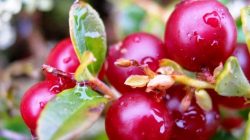
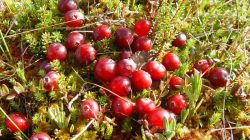


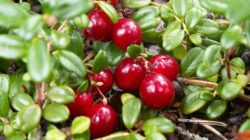


Cranberry bushes are also divided into wild and garden, which can be grown in your own garden:
- Swamp cranberry is the most common cranberry in the eastern hemisphere; the berries of this variety are bright red. Swamp cranberry contains a huge amount of vitamin C, as well as many micro- and macroelements. People have long noticed the beneficial properties of swamp cranberries and learned to use them: dried cranberries and cranberry compote were used in the treatment of vitamin deficiency, colds, and sore throats. The juice of the berry was used to lubricate open wounds to speed up healing. For example, Indian shamans made compresses from the juice of the berry, thanks to which the poison received from a wound with a poisonous arrow was drawn out of the wounds (the benefits of cranberries in treatment were enormous).
- Wild berries are considered one of the most useful berries growing in the wild; they grow not only in wetlands, but also in peat soil.
- Garden cranberry - this species can be grown on your own plot: it feels excellent in peat-rich soil. The berries of this variety are much larger than those of the wild plant, and planted shrubs can bear fruit for about half a century.
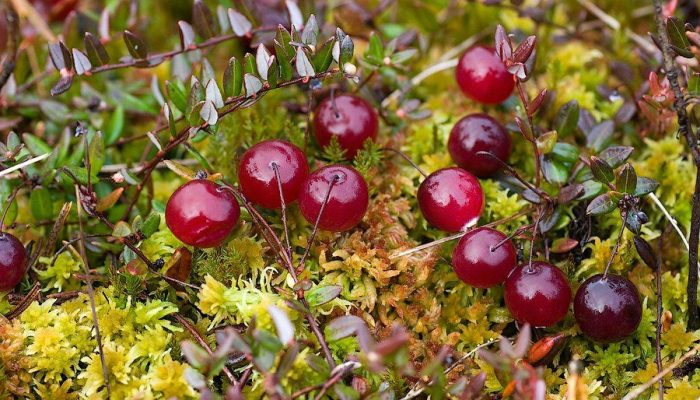
Description
Absolutely all species are small evergreen shrubs creeping along the ground with flexible thin stems from 15 to 30 cm that are rooted in the ground. The plant lives for a long time: the age of some species exceeds a hundred years.
The mineral solutions, nutrients and trace elements necessary for the cranberry bush enter the plant through the fungus located on its roots, which is tightly connected by its threads to the root system of the bush. Mushroom threads pull the necessary solutions from the soil, after which they transfer them to the roots of the bush.
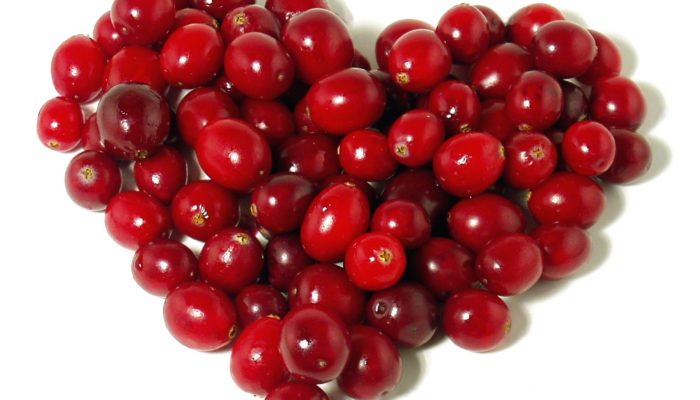
The leaves of cranberry bushes are dark green, ovate or oblong, arranged in a spiral, with one leaf coming from each node of the stem. The length of the leaves ranges from 3 to 16 mm, width – from 1 to 6 mm. Interestingly, there is wax on the bottom of the leaf, which prevents water from flooding the stomata, through which evaporation and gas exchange between the plant and nature occurs.
Cranberry bushes bloom for about eighteen days in late May - early June. The flowers of the shrub are pink or light purple, and the flower itself usually has four petals, but often has five.
Every year, several hundred hard dark red berries with a diameter of 8 to 16 mm appear on one bush. They ripen at the end of summer and are able to remain on the plant until spring without losing their qualities.
Ninety percent of cranberry berries consist of water, and they contain such a huge amount of medicinal properties that no one doubts the benefits of cranberries in our time. Among the organic compounds we can highlight:
- Vitamins A, B, PP, K1, C (interestingly, there is as much vitamin C here as in lemon, orange, grapefruit, strawberry);
- Fructose, glucose, sucrose, pectins;
- Phenol acids – reduce the risk of atherosclerosis by reducing the amount of bad cholesterol in the body;
- Potassium, iron, calcium, phosphorus, manganese, copper, iodine, tin, boron, zinc, silver, etc.
- Organic acids - primarily citric, malic, oxalic, benzoic, quinic.

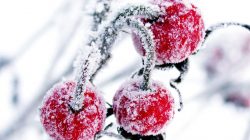
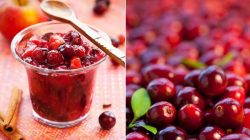
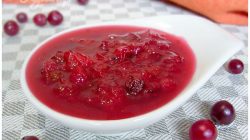
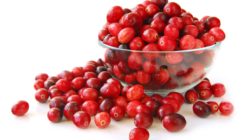
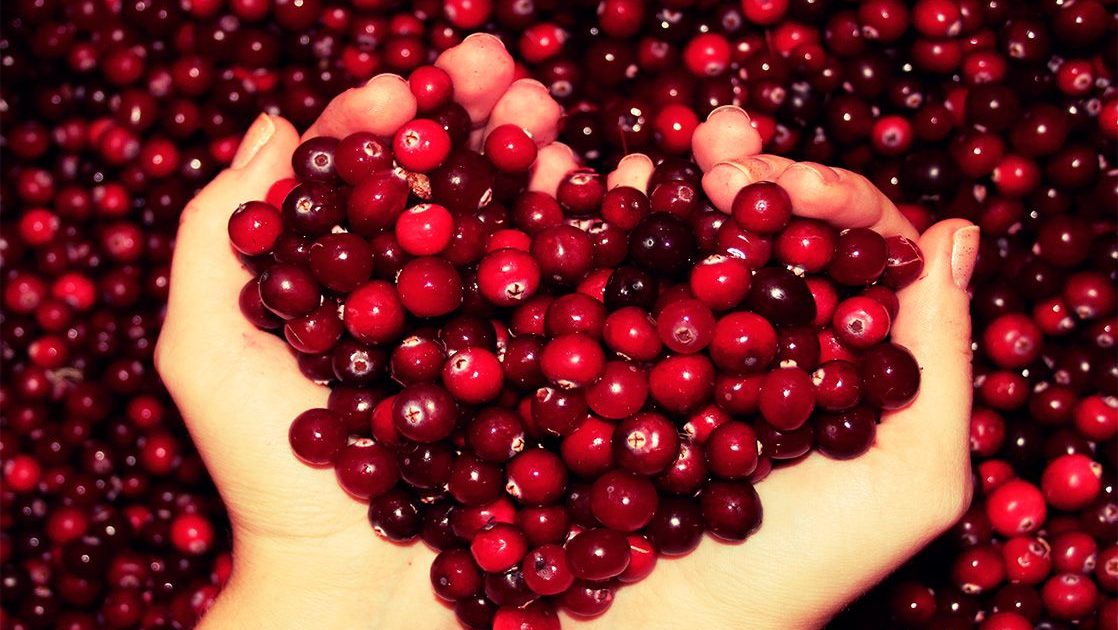

Application
Scientists, when they decided to determine how cranberry is useful, were surprised to find that it is one of the most medicinal berries found in the wild, and the properties of cranberries are such that it can successfully treat a sufficient number of diseases, including vitamin deficiency, colds, rheumatism, sore throat.
Recently, scientists are increasingly saying that cranberry drinks, as well as dried cranberries, are excellent for the prevention of colon cancer, prostate cancer and other malignant tumors. It is believed that cranberry compote, cranberry juice, and dried cranberries stop the formation of cancer cells.
It is worth noting that not only fresh berries, but also frozen cranberry juice, as well as brewed compote from recently harvested cranberries, are extremely healthy and have many medicinal properties. Cranberries in sugar are also tasty, and frozen and dried cranberries are stored for a long time and do not lose their beneficial health properties at all (it is not recommended to eat dried berries in large quantities, as you can gain weight).
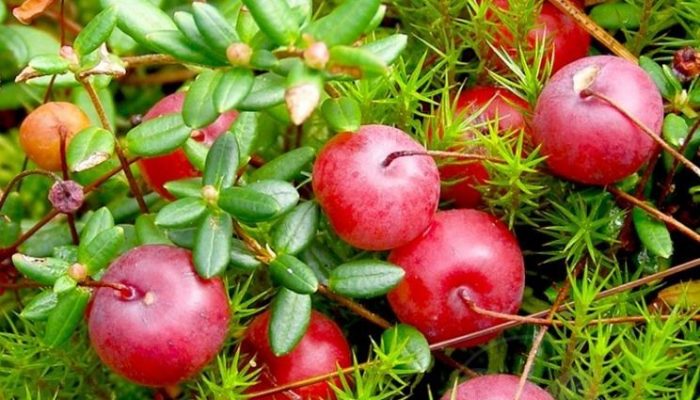
Frozen cranberries, if the necessary conditions are met, can be stored for about two years and medicinal properties cranberries don't disappear. When choosing frozen cranberries, you need to feel the packaging and make sure that the berries have not stuck together, otherwise the product has already been defrosted and, therefore, has lost most of its healing properties, so the medicinal benefits of cranberries are in doubt. When buying or removing frozen cranberries from the freezer, you must prepare them (make cranberry juice or cranberry compote). After defrosting, you can store it in a glass container for another three days or fill it with water and put it in the refrigerator (in this case it will last a long time).
Contraindications
Despite all their advantages, cranberries have contraindications. They should not be used by people with duodenal or stomach ulcers, as well as gastritis with high acidity.
People who have liver problems should use this product with caution (only after consulting with a doctor), since the berry can cause an aggravation.
You should also take into account the properties of cranberries, such as the ability to destroy tooth enamel. Persons with sensitive enamel or other dental problems should consume the berry carefully and not overuse it.
Name: the generic name is translated from Latin literally as sour ball.
Description:
According to some classifications, it is included in the genus Vaccinium, a separate subgenus; according to others, it is separated into the independent genus Oxycoccus. In the world, 4 types of cranberries grow in the tundra, forest-tundra and forest zones of Europe, Asia and North America. In Russia, 2 species grow under natural conditions (marsh and small-fruited) and a very wide variety of forms (the type and size of the berries are often not inferior to the American large-fruited cranberry). Cranberries grow in high bogs in the form of small creeping rooting bushes on almost recumbent peduncles, on which large red berries are formed, seemingly lying directly on the sphagnum moss.
| Cranberry four-petalled, common, swamp- Oxycoccus macrocarpus (Ait.) Pers.
It grows in sphagnum and sedge-sphagnum bogs, in the tundra, forest-tundra and forest belt of the European part of the country, in Siberia, the Far East, Kamchatka and Sakhalin Island. An evergreen creeping, branched shrub, with creeping, long, thin and flexible woody dark brown stems, up to 75 cm long and about 1 mm in diameter, with erect flower-bearing branches and short, thread-like, fluffy annual branches. Leaves on short petioles, leathery, oblong-ovate, up to 1.6 cm long, up to 0.6 cm wide, sharp at the apex, with entire curled edges, dark green and shiny above, bluish below with a waxy cadet, with a prominent bottom midrib. The flowers are drooping, arranged 1 or 2-4 in umbellate inflorescences on last year's branches. The pedicels are long (up to 4.5 cm), single-flowered, emerging from the axils of the scaly apical leaves, reddish, fluffy, bearing 2 small sharp bracts about 1 mm long. Cup with 4 rounded ones. Along the edges are thin- and long-ciliated sepals, about 1 mm long, first green, then red. The corolla is deeply 4-parted, 5-7 mm long and 1.5-2 mm wide, with pink-red, oblong-lanceolate lobes 4-6 mm long, curved outward and backward. There are 9 stamens, with short filaments and anthers almost equal to them. The ovary is 4-locular, the style is slightly longer than the stamens and, together with them, stands out from the corolla. The berry is spherical, large, 9.8-1.8 cm in diameter, weight of 1 berry is 0.5-1.5 g, dark red, juicy, sour, 4-locular, multi-seeded, on a stalk, overwintering. Seeds are 1.5-2.8 mm long, ovoid. Flowering - from late May to early June. The berries ripen (in early and mid-ripening varieties) in late August - early September, that is, 2-3 weeks earlier than large-fruited cranberries. However, the size of the increments and the growth vigor of bog cranberry bushes are significantly (almost half) less. In the spring, after the snow has melted, you can collect the so-called snow cranberries that remain for the winter, which are sweeter, but less transportable and worse stored. Abundant fruiting periodically. This species is characterized by large intraspecific plant variability in the shape and size of the leaf, the number of flowers in the inflorescence, the size, shape and color of the fruit. In GBS since 1975, 2 samples (5 copies) were grown from seeds obtained from the Netherlands and the USA (New Jersey). The length of the shoots of the shrub at 7 years is 180 cm. The dimensions of one clump are 100 x 130 cm. Vegetation from 7.V±4 until autumn frosts. It grows quite quickly, especially in breadth. First flowering and fruiting at 7 years of age. Blooms from 6.VII±3 to 8.VIII±5, about 1 month. It bears fruit annually, but not profusely; the fruits ripen in mid-October. Propagated by seeds and cuttings. Winter hardiness is high. The berries are susceptible to diseases and pests. Seed germination rate is 68%. Roots up to 100% of cuttings in acidic peat without stimulants. The productivity of swamp cranberries in the Moscow region is low (200 g per 1 m2), and in addition, plants in the garden noticeably suffer from even a short-term lack of moisture, especially in early spring. The consequences affect the delay in the development and fruiting of bushes for more than one year. For the garden, the most interesting are large-fruited selections of wild bog cranberry specimens. For planting material with relatively large fruits, we recommend contacting collectors in Moscow, the Vladimir and Nizhny Novgorod regions, the GBS of the Academy of Sciences, or for advice from residents of the Klinsky district, where the largest cranberries in the Moscow region have long been collected in the swamps. Cranberry variety Gift of Kostroma average ripening period. The berries are large and very large, with an average weight of 1.9 g, sour, without aroma. They contain: sugar – 6.0%, acid – 3.0%, vitamin C – 35 mg%. Tasting score – 4 points. The average yield is 984 g per 1 m2. The bush is medium-sized, creeping. The shoots are medium thick, pubescent. The leaves are large and green. The leaf blade is bare, shiny, leathery. The flowers are large, pale pink. Plants remain resistant to low temperatures (-33 C) under snow cover. Susceptibility to snow mold without winter water filling is 4 points, with water filling – 1 point. No pest damage was noted. The optimal groundwater level is 20-35 cm. Requires high-moor or transitional peat soils. Photo by EDSR. |
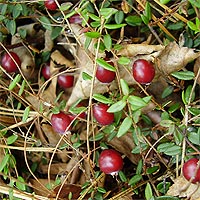 Small-fruited cranberry- Oxycoccus microcarpus Rupr. Small-fruited cranberry- Oxycoccus microcarpus Rupr.
Inhabits tundra and forest zones, mountain tundra, alpine and subalpine mountain zones of the northern hemisphere. Often found in swamps, along hummocks and ridges. Small-fruited cranberries are very similar to four-petalled cranberries, but differ from them in their smaller sizes. Perennial evergreen creeping subshrub with thin shoots up to 50 cm long and up to 0.6 mm thick. Leaves are up to 0.7 cm long and up to 0.2 cm wide, ovate, pointed, with strongly curled edges. The flowers are pink or dark pink, similar to tiny cyclamen flowers. The berries are spherical or oblong-ovoid, red, 3-10 mm in diameter, berry weight 0.2-0.3 g. Up to 3 berries are formed in the inflorescence. The berries have the same properties as four-leaf cranberries, but due to their small size and low yield, the population does not collect them. Blooms in June, July. Fruits in September. Photo by Marina Bakulina |
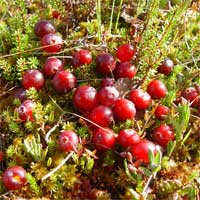 Large cranberry- Oxycoccus palustris Pers. Large cranberry- Oxycoccus palustris Pers.
Arctic, European part of Russia, Western and Eastern Siberia, Far East, middle Asia, North America, China, Japan, Western Europe. Grows in sphagnum bogs, in forest-tundra and forest zones, in thickets or continuous carpets, in mountains up to an altitude of 1550 m above sea level. seas. Protected in nature reserves. It is similar to four-petalled cranberries and small-fruited cranberries, but differs in vigorous growth and vigor of a shrub. The creeping stems are up to 2.2 m long, up to 4 mm thick, and a large number of erect fruit-bearing shoots rise from them, rising 15-20 cm, forming a thick cover over the entire surface. These shoots do not branch; they have very short internodes and a large number of buds. The berry harvest depends on the number of these shoots, the optimal number of which per 1 m3 is from 2 to 3 thousand pieces. The leaves are elliptical, up to 22 m long, up to 9 mm wide, flat or with slightly curled edges. The bracts are leaf-shaped, located in the upper part of short-pubescent pedicels. The flowers are pale pink, almost white, petals are 6-10 mm long, collected in racemes of up to 15 flowers. In winter, flower buds leave with differentiated primordia of stamens and pistils. The formation of flower buds begins in the first ten days of July and ends in the second half of August, and the formation of stamens and pistils in the buds occurs in September-October. Flowering occurs from the second half of June to early July. Ripening of berries, depending on weather conditions late summer - late September - October. Early varieties ripen until mid-October and therefore ripen reliably. The content of biologically active substances in large-fruited cranberries is approximately the same as in four-leaf cranberries. Just like the four-petalled cranberry, it has a wide variety of shapes. In North America, it was introduced into culture more than 150 years ago. About 200 varieties have been created, which are grown on industrial plantations with a total area of more than 12 thousand hectares. The yield is 1-2 kg. In GBS since 1969, 1 sample from the Moscow region. Evergreen shrub. Vegetation from late April until autumn frosts for 178 days. It blooms weakly, but annually, from 25.V±2 to 18.VI+5, for about 3 weeks. The fruits set irregularly and ripen at the end of September. Propagated by seeds, cuttings, dividing bushes in early spring. Winter hardiness is complete. Seed germination up to 50%. When summer cuttings are treated with a 0.01% IBA solution for 16 hours, 47% of the cuttings take root. Varieties that can be found in the collections of institutions and gardeners: Washington, Bergman, Beckwith, Early Black, Franklin, Hoves (from the USA), McFarlin, Black Vale and Wilcox (obtained from Lithuania in the early 70s), Searles, Stevens , Ben Lear (obtained from Canada in 1983). Of these, the early varieties - Franklin, Washington, Black Vale and Wilcox - ripen more reliably in the conditions of the Moscow region. Productivity varies from 500 g to 1 kg per 1 m2 of plantation. Black Vale is the least productive variety of these four (yield ranges from 400-600 g per 1 m2). Here a brief description of some introduced varieties of large-fruited cranberries: Beckwith - berries ripen in the second half of September, their length is up to 28 mm, diameter up to 18 mm; weight of 100 berries 127g. Average yield 838 g/m2, maximum 1316 t] Stevens berries ripen in mid-September, up to 22 mm long, up to 18 mm in diameter, weight of 100 berries 134 g. Average yield 894 g/m2, maximum 1334 g/m2. Franklin - the berries ripen in the first half of September, their length is up to 17 mm, their diameter is up to 16 mm, the weight of 100 berries is 117 g. The average yield is 1289 g/m3, the maximum is 2186 g/m2. Hoves - the berries ripen late, in early October, the length of the berries is up to 19 mm, the diameter is up to 17 mm, the weight of 100 berries is 134 g. The average yield is 1239 g/m2, maximum 1933 g/m2. Early Black is a fast-growing variety, the berries ripen in the first half of September, the length of the berries is up to 16 mm, the diameter is up to 15 mm, the weight of 100 g of fruit is 87 g. The average yield is 1255 g/m2, the maximum is 2240 g/m2. The crop is more flexible in the garden and is worthy of the attention of landscape designers, as it turns out to be quite durable (in nature - up to 60 years, in the garden - at least 30 years) with the correct location of the planting zone. Photo by Kirill Tkachenko |
Location: grows best in open, well-lit places, with a groundwater level of 25 cm. It is hardy in unfavorable conditions, has exceptional winter hardiness, and is indifferent to unstable thermal conditions of air and soil, poverty of mineral nutrition, periodic excess or lack of moisture. Additional penumbra from big trees the garden is useful for cranberries: it retains the ability to vegetate, mature and bear fruit at the same pace, while its competitors are suppressed.
The soil: acidic, for common and microfruited cranberries with a pH of 2.5-6.5., for large-fruited cranberries, soil acidity is in the range of 3.2-5. Good aeration of the substrate is necessary. Cranberries have significant ecological plasticity and can grow within a fairly wide range of water and air supply of the substrate, optimization of which is solved in 2 ways: regulation of the groundwater level and irrigation by fine-drip sprinkling. Quite suitable (without major soil replacements) are areas developed on former peat mining sites, as well as on natural depressions - saucers from massifs of former fields adjacent to the forest. If there is a different type of soil on the site, then for planting large-fruited cranberries it should be replaced to a depth of 25-40 cm with peat, adding forest humus, leaf soil, sand and a little semi-decomposed (in appearance - peat) litter from a coniferous forest. When laying appropriate soil and planting seedlings, it is important to provide these tree species with reliable drainage (local use of plastic drainage pipes is possible). Swamp cranberries are grown on clean sphagnum peat, with a minimum peat horizon thickness of 50 cm. Cranberries tolerate poor soils and almost do not suffer from waterlogging.
Landing: cranberry planting material is “not without sin.” If it is from the forest, it will naturally become a source of weeds; if it is from a nursery, it will certainly not be as resistant to diseases and pests as its wild relative. One good thing is that seedlings from a nursery usually (even more so varietal ones) have predictable characteristics and are less capricious when transplanted. The entire substrate should be spilled so that the groundwater level is at a depth of 20-30 cm from the surface of the substrate. Then cranberry seedlings are planted, 2 pieces each. into the nest. The planting pattern is 20x20 cm to a depth of 10 cm. Cuttings can be planted small (5 cm): they take root well, but it is better to plant larger cuttings (for example, 20 cm), since they take root faster and by autumn, form an increase of 20- 24 cm. In the second year, the rooted cuttings continue to grow intensively and form growth. In the fourth year, the plants close together, many of them begin to bear fruit, mass flowering and fruiting occurs in the fifth year with a yield of 500 g/m2. When cutting and cultivating cranberries, the most important conditions are the creation of an optimal nutrient water-air regime of the substrate, lighting, and ensuring timely weeding.
Care: responds well to constant moisture. You should strive to stimulate the growth of shoots in the first 2-3 years from the establishment of cranberry plantings. Fertilizer doses should be reduced year after year and reduced to a minimum by the third year. By this time, the increase in the mass of shoots will also stop. It is while the bush is growing that you can lay the foundation for its shape - compact (removing vertical shoots) or low spreading (stimulating the growth and formation of horizontal branches). The second option (spreading bush) is less reliable; it requires shelter for the winter and the prospect of weak fruiting. It is better to form a compact tall bush, while removing low-winter-hardy creeping shoots and stimulating the growth of only vertical shoots. To create taller bushes, regularly prune all horizontal shoots. This sometimes allows the formation of a kind of vertical skeleton, which makes it easier to pick berries. When cultivating American large-fruited cranberries, it turned out that the dose of mineral fertilizers depends on the height of the erect fruit-bearing shoots: the higher the shoots, the less fertilizer. In the middle zone and further south it can dry out in winter due to lack of moisture, so some authors recommend covering it with spunbond when frost sets in.
Reproduction: Under natural conditions, it mainly reproduces vegetatively, forming adventitious roots on lying shoots, and by seeds. In cultivation, all types of cranberries are easily propagated by green cuttings and seeds. Green cuttings, prepared during the period of intensive shoot growth and planted for rooting in a substrate with bedding peat, take root 100%. The length of the cuttings is from 5 to 20 cm, the planting pattern is 2x5 cm, the planting depth is 2-3 cm; After undergoing stratification at a temperature of +4 C for 5 months, the seeds germinate amicably. The best substrate was litter peat; after 2 months, the height of the seedlings was within 10-20 cm.
Usage: for decorating shady corners of the garden, creating heaths and cranberry fields.
Perennials for decorating cranberries should be selected, focusing on species that are low-growing and unobtrusive in flowering, in order to somewhat diversify the modesty and unpretentiousness of forest berry plants. The use of stone will make the new landscape even more advantageous, but large rounded boulders that do not impede the passage between the bushes are desirable here. Cranberries can be suitable for planting on a flat area or at the foot of a slope in a relief area.
There must be mature trees nearby, creating scattered shade for the group of lingonberries. This function is best performed by varietal rowan trees with an openwork crown (if there are already mature trees), large viburnums or euonymus. Young vigorous conifers of sufficiently large size (about 7-10 m high) - spruce, pine, slow-growing species (giant thuja) - will not do any harm in creating diffuse partial shade. If only young seedlings of trees and ornamental shrubs are used, then temporary shading of lingonberry plantings is necessary (for the first month or two after planting).
A smooth transition to the lawn can be ensured by several coniferous groups located on its border, as well as soil-unpretentious viburnum gourdovina, low-growing Ginnala maple, and dwarf shrub-type rowan trees (elderberry or Kene rowan) with an openwork light crown. A little higher, in more illuminated areas, you can place Vilmorin's mountain ash, and then, in the zone of acidic soils, rhododendrons.
Many large gardens offer easy access to shaded areas with interesting topography, and the edges of large estates often have slopes or hills covered with mature trees. Lingonberry and cranberry terraces-meadows are appropriate here. They should be placed in tiers, preferably on leveled horizontal mini-plateaus, for which the topography of the site should be somewhat transformed (terraced).
The style and idea of the “sour lingonberry” slide are based on preserving the natural forest landscape. This is also facilitated by the location of the “sour” slide, which is relatively remote from the house. Its dimensions are incomparably larger than a small typical hill, since it is rather a defined territory where there is no strict boundary between the rocky and garden parts. The sour hill does not really fit in with the style used in the design of house facades and open garden areas. The proximity of bright plantings is inappropriate here, as it can disrupt the feeling of naturalness of this mini-landscape with stone.
Partners: Many species of ornamental shrubs with a relatively shallow but branched root system (spirea and some other shade-tolerant species) can inhibit it near cranberries, so they disappear when arranging groups or must be moved away from cranberries and other lingonberries. Large perennials and species that require high doses of macroelements are completely unsuitable in the vicinity of lingonberries. Perennials with stolon-shaped roots (Rogersia, Buzulnik) are very undesirable here. They can ruin all your efforts. Lily of the valley, periwinkle, and goldenrod, on the contrary, are completely safe for “cranberry growers,” since they colonize another soil horizon that is indifferent to cranberries.
Ermakov B.S., Forest plants in your garden. 1992. Moscow, "Ecology"
L. YURINA, L. MIKHALCHIK “Don’t go to the swamp” // “AiF At the Dacha” Internet version, #19 (86) 05/10/2000
Everyone knows that cranberry is one of the most useful gifts of nature; it is very good in the treatment of many diseases. However, not everyone knows exactly what healing properties it has, where cranberries grow, how and when is the best time to collect them, and how to properly store the berries. This gap needs to be filled.
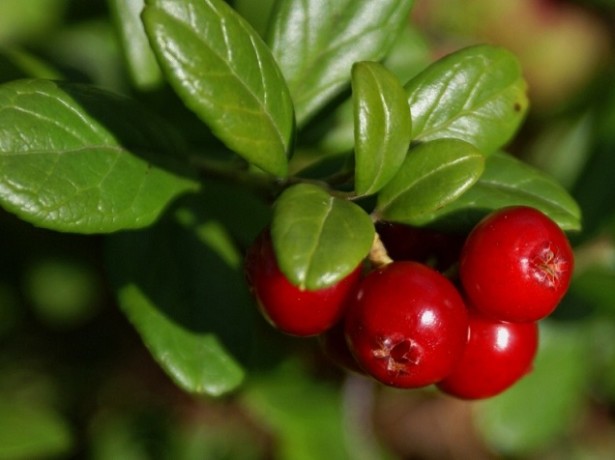
Cranberry fruits contain many rare trace elements
The genus cranberry itself has three types: ordinary, small-fruited, and large-fruited. The latter is sometimes also called American. In Russia, common and small-fruited varieties grow. The second lives mainly near the Arctic Circle, in tundras, forest-tundras, and northern swamps. The common one is found everywhere in wet hollows or swamps throughout Russia, excluding the southern Volga region, Kuban, and the Caucasus. In Europe it grows north of Paris, and in North America– from Chicago, covering all of Canada. The range of the large-fruited variety covers the Appalachian Mountains region.
This berry loves moist, undisturbed economic activity a person of place, she is very sensitive to the state of the environment. So most often cranberries grow in taiga swamps or in wet lowlands and mountain hills. The main thing is that there is enough water and the soil is fertile.
Video about the healing properties of cranberries
Cranberry fruits contain many rare microelements: selenium, lutein, manganese, zeaxanthin. They are used in the treatment of colds inflammatory diseases, as an antipyretic and pathogenic microflora inhibitor. Cranberry fruits are also used to treat rheumatism and scurvy. Since they contain a lot of vitamins C and K, they are not recommended for consumption by people suffering from stomach ulcers or other diseases of the digestive system. Cranberry juice can act as an irritant.
Before the invention of antibiotics, folk healers used willow bark and cranberry juice; their principle of action is similar to penicillin, although weaker.
People have been collecting healthy berries for a long time. This culture, due to its special distance from human habitation, requires great responsibility and attention from berry growers. It is more difficult to harvest than lingonberries or blueberries. The fact is that it spreads along the soil, intertwined with a carpet of thin branches. In other words, cranberries grow like any marsh grass.
When you come across a cranberry tree, you can’t immediately see where the berries are, which look like ruby beads. They are hidden almost right next to the soil under the greenery. For ease of collection, people use special long combs made of wood or bone. Lifting the branches with them makes it very convenient to remove berries from the plant.
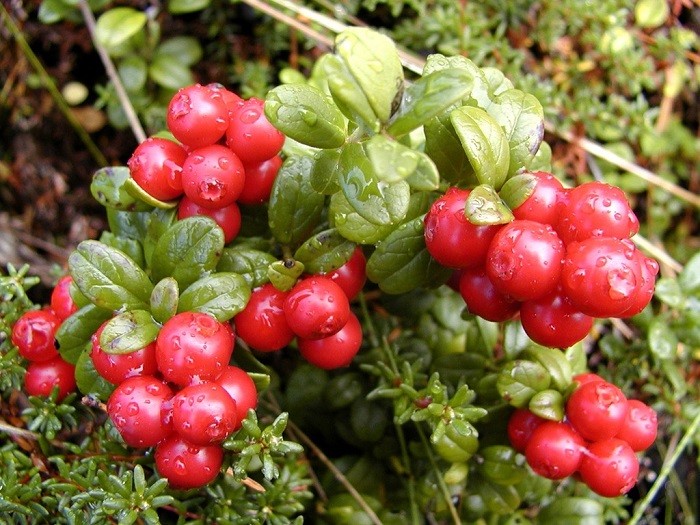
When you come across a cranberry tree, you can’t immediately see where the berries are, they look like ruby beads
The harvest ripens late, later than all other forest berries. Can be collected until the winter cold. Frosts are not scary for her.
Now let's consider step by step instructions cranberry storage:
- Wash the berries, remove crushed, damaged, overripe ones
- We prepare an enamel bucket or large jar, thoroughly wash the container with soda and no other detergents.
- Pour containers with water reserve into the washed container.
- Fill everything with cold boiled water so that the berries are hidden. The water level should be about two centimeters above the berries.
- Cover the top with parchment and tie it with a tourniquet.
- Place the soaked berries in a cool room, out of direct sunlight.
In this form, the fruits will be stored all winter, without losing either taste or usefulness. There are variations of this recipe for storing cranberries. This is soaking in sugar syrup. All steps are similar to those above, only we use cold syrup instead of water. You can also store the crop under pressure. The berries, laid out in containers and filled with water, are pressed down with a wooden circle, on top of which a load is placed. Also keep this in a cool place.
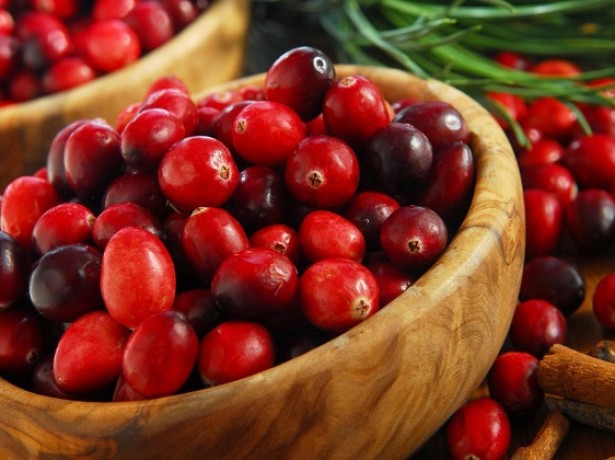
The berries, laid out in containers and filled with water, are pressed down with a wooden circle, on top of which a load is placed
Cranberry juice, as well as cranberry juice, are also easily stored without becoming sour or moldy. This is thanks to large doses of ascorbic and folic acid, which work as a natural preservative.
Cranberries in the forest and garden
Gardeners and naturalists have long tried unsuccessfully to grow swamp sweets in their own plots. As in the case of lingonberries and blueberries, it turned out that the European cranberry is a plant too dependent on the general ecosystem of the forest, which is why attempts to transfer it to the garden failed every time. Cultural forms of this forest delicacy appeared relatively recently, from the end of the 19th century in North America. Breeders developed the first successful varieties of garden crops based on large-fruited cranberries growing only there.
As it turned out, it is this species that best adapts to garden conditions and responds to watering with fertilizers with a significant increase in yield. Now there are a large number of different varietal groups and hybrids, varying in terms of ripening, yield, winter hardiness, and fruit size. Garden cranberries are also larger than wild cranberries and raise clusters of berries above the ground, which makes them easier to harvest industrially.
Previously, the main share of exports came from Nordic countries where it grows in abundance: Russia, Finland, Sweden. Nowadays, the collection of natural cranberries is not widespread. Modern agricultural industry fully satisfies the demand for it. The leader in the number of cranberry plantations and yields is the United States of America.
Video about cranberries in your garden
In terms of taste and beneficial properties, garden cranberries are practically in no way inferior to their swamp relatives. The only thing is that the current volume of harvesting does not allow storing and transporting the harvest the way residents of taiga villages do, soaking the berries, when all the beneficial properties and taste are preserved for a very long time. Nowadays, most often on store shelves you can find frozen cranberries, which, of course, taste blander and worse than fresh or pickled ones. Fresh berries are available for sale only during the harvest season. This is from October to January.
We all know that cranberries are very tasty. But not everyone knows what exactly its benefits are, how to properly collect cranberries and where they grow. Let's make these points clear.
Cranberries are a real storehouse of vitamins. It is useful both fresh and dried. Cranberries are used in the food industry, cooking and folk medicine. It makes very tasty jelly and teas. Cranberries contain a large amount of vitamin C, as well as rare microelements lutein, selenium, and manganese. It is used to prevent colds, treat scurvy and cough, as a natural antipyretic.
Cranberries come in large and small fruits. The latter is grown on an industrial scale in Canada, the USA, and Scandinavian countries. Small-fruited cranberries grow in the tundra and forest-tundra, near the Arctic Circle. There is another variety of cranberry, called ordinary: it is found throughout the middle zone.
Cranberries grow not only in swamps, but also in any lowlands with high humidity: in damp sphagnum coniferous forests, along the shores of swampy lakes, etc. Now let’s find out exactly where to go for cranberries.
Where do cranberries grow in Russia?
Cranberries collected with your own hands in an ecologically clean area are much healthier than those bought in a store. It grows throughout almost the entire territory of Russia, except for the Kuban, Caucasus and the southern part of the Volga region. Even in the Far East and the Arctic Circle you can find this unique berry!
Interestingly, cranberries are predominantly a “wild” plant. It is very sensitive to the environmental situation: under any unfavorable factors, the berry simply disappears from places disturbed by human economic activity.
Where do cranberries grow in Ukraine?
The Carpathians, Carpathian region and Polesie are the main growing areas for cranberries in the wild nature of Ukraine. However, there is not as much of it left as before - the plant is dying out. The reason for this was incorrect, illiterate picking of berries. If you go to a swamp or peat bog to pick cranberries, take the time to familiarize yourself with the basic rules for collecting this capricious berry:
- Ideally, you need to pick cranberries one at a time, selecting the ripest and largest berries. But you can also use a special scoop to collect cranberries.
- All collected berries should be sorted, removing debris and damaged fruits.
- There are several ways to store cranberries: frozen or soaked, or in a cool, dry room.
Where do cranberries grow in Belarus?
The raised bogs of Belarus are a paradise for cranberry lovers. Due to the fact that there is an impassable swamp in the Vitebsk and Minsk regions, a lot of cranberries can be collected here. In the Gantsevichi district of the Brest region, it is grown for sale artificially, in checks. You can collect cranberries in swamps or forests in three seasons:

If you have a very long way to go for cranberries, think about planting this plant in your own garden. If you are able to provide the conditions necessary for growth and fruiting (high humidity, plenty of light), this will not be difficult. Cranberries grow quickly, and from just a few seedlings that take root this season, in a year you will already have a whole cranberry bed. This berry is also completely unpretentious to grow. Let us only note that common cranberries grow on acidic soils, which means that before planting it is advisable to add peat, sphagnum, oak leaf compost, manure, sulfur or iron sulfate to the future bed.
